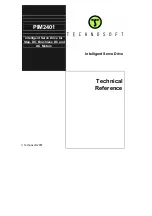
8.13 Manual Tuning
8.13.1 Tuning the Servo Gains
8-83
8
T
uning
Model Following Control Bias in the Forward Direction and Model Following Control Bias in
the Reverse Direction
If the response is different for forward and reverse operation, use the following parameters for
fine-tuning.
If you decrease the settings, the response characteristic will be lowered but overshooting will
be less likely to occur.
Model Following Control Speed Feedforward Compensation
If overshooting occurs even after you adjust the model following control gain, model following
control bias in the forward direction, and model following control bias in the reverse direction,
you may be able to improve performance by setting the following parameter.
If you decrease the settings, the response characteristic will be lowered but overshooting will
be less likely to occur.
Model Following Control Type Selection
When you enable model following control, you can select the model following control type. Nor-
mally, set Pn14F to n.
1 (Use model following control type 2) (default setting). If compati-
bility with previous models is required, set Pn14F to n.
0 (Use model following control type
1).
Pn143
Model Following Control Bias in the Forward Direction
Setting Range
Setting Unit
Default Setting
When Enabled
Classification
0 to 10,000
0.1%
1,000
Immediately
Tuning
Pn144
Model Following Control Bias in the Reverse Direction
Setting Range
Setting Unit
Default Setting
When Enabled
Classification
0 to 10,000
0.1%
1,000
Immediately
Tuning
Pn147
Model Following Control Speed Feedforward Compensation
Setting Range
Setting Unit
Default Setting
When Enabled
Classification
0 to 10,000
0.1%
1,000
Immediately
Tuning
Parameter
Meaning
When Enabled
Classification
Pn14F
n.
0
Use model following control type 1.
After restart
Tuning
n.
1
(default setting)
Use model following control type 2.
















































